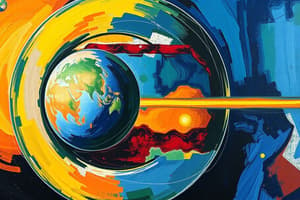Podcast
Questions and Answers
Which layer of the Earth is known for being the outermost layer?
Which layer of the Earth is known for being the outermost layer?
- Crust (correct)
- Outer Core
- Mantle
- Inner Core
What is the primary source of Earth's magnetic field?
What is the primary source of Earth's magnetic field?
- Solid rock in the mantle
- Flow of molten iron in the outer core (correct)
- Movement of tectonic plates
- Sun's solar wind
Which of the following is NOT one of Earth's four major spheres?
Which of the following is NOT one of Earth's four major spheres?
- Lithosphere
- Atmosphere
- Biosphere
- Astronomy (correct)
Which process is a part of how matter and energy cycle on Earth?
Which process is a part of how matter and energy cycle on Earth?
Which characteristic is associated with the Earth's mantle?
Which characteristic is associated with the Earth's mantle?
Which component is part of Earth's energy budget?
Which component is part of Earth's energy budget?
In which layer of the Earth does the geochemical cycle primarily occur?
In which layer of the Earth does the geochemical cycle primarily occur?
What role does gravity play in Earth's system?
What role does gravity play in Earth's system?
What are the four spheres of Earth?
What are the four spheres of Earth?
What is the primary composition of the Earth's atmosphere?
What is the primary composition of the Earth's atmosphere?
What percentage of Earth’s surface is covered by the global ocean?
What percentage of Earth’s surface is covered by the global ocean?
Why do scientists rely on indirect observations to study Earth's interior?
Why do scientists rely on indirect observations to study Earth's interior?
Which sphere of the Earth is known as the solid part of the planet?
Which sphere of the Earth is known as the solid part of the planet?
What shape is the Earth when viewed from space?
What shape is the Earth when viewed from space?
How does the atmosphere support life on Earth?
How does the atmosphere support life on Earth?
What are the primary energy sources in the Earth system?
What are the primary energy sources in the Earth system?
What type of energy generation is responsible for heating Earth's interior?
What type of energy generation is responsible for heating Earth's interior?
What percentage of Earth's water is contained in the oceans?
What percentage of Earth's water is contained in the oceans?
What is the equatorial circumference of the Earth?
What is the equatorial circumference of the Earth?
Which statement about Earth is NOT true?
Which statement about Earth is NOT true?
Which sphere is described as a thin layer where all forms of life exist?
Which sphere is described as a thin layer where all forms of life exist?
What is Earth's pole-to-pole circumference?
What is Earth's pole-to-pole circumference?
What occurs between Earth's spheres that maintains energy balance?
What occurs between Earth's spheres that maintains energy balance?
What is the role of carbon dioxide in the atmosphere?
What is the role of carbon dioxide in the atmosphere?
What role do nitrogen-fixing bacteria play in the nitrogen cycle?
What role do nitrogen-fixing bacteria play in the nitrogen cycle?
How does carbon move through the short-term carbon cycle?
How does carbon move through the short-term carbon cycle?
What is the primary reason phosphorus does not exist in the atmosphere?
What is the primary reason phosphorus does not exist in the atmosphere?
Which process is involved in the long-term carbon cycle?
Which process is involved in the long-term carbon cycle?
What leads to the return of nitrogen compounds to the soil after animals consume plants?
What leads to the return of nitrogen compounds to the soil after animals consume plants?
What part of the phosphorus cycle allows phosphorus to enter soil and water?
What part of the phosphorus cycle allows phosphorus to enter soil and water?
In what way is nitrogen cycling similar to carbon cycling?
In what way is nitrogen cycling similar to carbon cycling?
Which of these statements correctly describes the phosphorus cycle?
Which of these statements correctly describes the phosphorus cycle?
How do plants absorb phosphorus in the phosphorus cycle?
How do plants absorb phosphorus in the phosphorus cycle?
What process returns phosphorus to the environment after an animal dies?
What process returns phosphorus to the environment after an animal dies?
What is the primary characteristic of a closed system?
What is the primary characteristic of a closed system?
What is the cyclical process that describes the movement of water from the atmosphere to Earth's surface and back?
What is the cyclical process that describes the movement of water from the atmosphere to Earth's surface and back?
What is indicated by Earth's magnetic field extending into space?
What is indicated by Earth's magnetic field extending into space?
How much of Earth’s surface is covered by water?
How much of Earth’s surface is covered by water?
What happens to water during evaporation in the water cycle?
What happens to water during evaporation in the water cycle?
What type of system allows both energy and matter to enter and leave?
What type of system allows both energy and matter to enter and leave?
Study Notes
Earth & Earth as a System
- Designed to explore the composition and structure of Earth's interior.
- Identifies sources of Earth's magnetic field.
- Lists characteristics of Earth's four major spheres.
- Explores four processes where matter and energy cycle on Earth.
Earth's Physical Structure
- Earth is the third planet from the sun and the only one known to support life.
- Approximately 70% of Earth's surface is covered by the global ocean.
- Earth is an oblate spheroid, with a pole-to-pole circumference of 40,007 km and an equatorial circumference of 40,074 km.
Earth's Four Spheres
- Atmosphere: Gaseous layer above Earth, 78% nitrogen and 21% oxygen, regulates climate and supports life.
- Biosphere: The zone of life; includes all ecosystems on land and in water, existing as a thin layer on Earth’s surface.
- Geosphere: The solid Earth, encompassing core, mantle, and crust.
- Hydrosphere: Contains all water on Earth, covering 71% of the surface; includes oceans, glaciers, and groundwater.
Earth's Energy Budget
- All four spheres act as open systems, exchanging matter and energy continuously.
- Internal energy sources include heat from radioactive decay and gravitational contraction.
- Nitrogen-fixing bacteria play a role in the nitrogen cycle by converting atmospheric nitrogen into usable forms for plants.
Biogeochemical Cycles
- Carbon Cycle: Involves both short-term (photosynthesis and respiration) and long-term (sedimentation and fossilization) processes for carbon movement across spheres.
- Phosphorus Cycle: Phosphorus rarely exists as a gas; it cycles through soil and water, essential for building cells.
- Water Cycle: Continuous movement of water between the atmosphere and Earth's surface through processes like evaporation and transpiration.
Lesson Summary
- Earth has an average diameter of 12,756 km and is partially covered by water.
- Seismic waves confirm multiple layers within Earth's interior with varying densities.
- Earth's magnetic field extends into space, forming the magnetosphere.
- Distinction between closed (matter static) and open (matter and energy exchange) systems in Earth science.
Studying That Suits You
Use AI to generate personalized quizzes and flashcards to suit your learning preferences.
Description
This quiz focuses on the composition and structure of Earth's interior and its four major spheres: atmosphere, biosphere, geosphere, and hydrosphere. Explore how matter and energy cycle through these systems and gain a deeper understanding of Earth's physical structure. Test your knowledge on the planet that supports life and its key characteristics.




